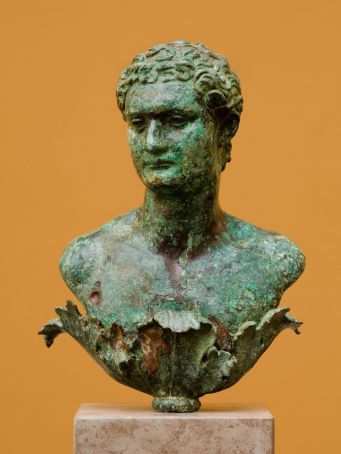An exhibition in Rome attempts to re-dimension the life and death of Domitian, last of the Flavian emperors (81-96 AD).
"Woe is me, I think I am becoming a god," complained the famously down-to-earth Vespasian on his deathbed. On loan from the Farnesi collection in Naples and here occupying about ten metres of wall space, the head of the same ‘divinised’ emperor and founder of the Flavian dynasty is a central exhibit of this enthralling show in the Capitoline Museums.
If anything, the ‘caput’ is bigger than that of Constantine in the museum courtyard below. And is equally intact. Except above the forehead has, somewhere in history, been neatly sliced off, so the rest of the head could be used as a basin: Look for the hole drilled through the ear.
And why no giant head for Domitian? The reason is in the damnatio memoriae in the reign of his successor, the emperor Nerva. As here, several heads of Domitian do survive, but each a tenth or less of the size of his father’s (Vespasian) or his brother (Titus). Proving that damnatio memoriae, given the thousands of heads ordered then sent throughout the empire, was only partial. Sheer numbers of them in circulation is one explanation.
Erasing Domitian
The same with coins, one here showing Domitian’s face rubbed out, another coin intact. Another factor was that defacement would decrease their worth. Also there’s the sheer effort involved. Penn Museum in Pennsylvania hosts a plaque to Domitian where the first line of lettering is erased, the following lines only partly so as the ancient workmen grew tired. Or maybe their chisels broke? Then, come references to Domitian in Egyptian hieroglyphs, still untouched thanks to the limitations in his opponent’s language skills.
But back to commemorative heads. Fished up from the Tiber here is one of verdant copper small enough to fit inside the palm of one’s hand, presumably thrown there to meet the senate’s decree. The one truly monumental-size statue doing Domitian honour is a 2.5m-high silky basalt baby Hercules complete with leonine head-dress. The ecstatic statue-felling senators vividly described by Pliny the Younger must have overlooked Diocletian’s order that the statue’s face be modelled on his own.

So Diocletian has gone down in history as one of the ten worst emperors, a byword for random cruelty, paranoia and a ratbag of other vices. Historian/gossip monger Suetonius, writing under “a good emperor” Hadrian, explains Domitian’s character along the same lines as he had previously used for Caligula. Id est. Domitian starts out as the senate’s bonus princeps whose reddish complexion was seen as a sign of youthful modesty, but ends up a monster as power and suspicion get the better (or worse) of him.
No good qualities?
That imperial blush, to another writer, signaled nothing but shame. Dio Cassius, an ex-senator writing in Greek, Pliny and the historian Tacitus are all loath to concede that Domitian had any good qualities at all. Tacitus implicates the emperor in Julius Agricola’s death, though this might be balanced by the more concrete fact that Agricola, ex-governor of Britain, was the historian’s father-in-law.
Most damning of all is Juvenal who renames Domitian the ‘bald Nero’. The poet’s Satire IV accuses him of filling his court with foreigners and upstarts. Still more repulsive is Satire II’s accusation of Domitian’s temporarily abandoning his wife Domitia for Julia, his niece, then forcing on her an abortion from which she died. ‘…his too-fertile niece gobbled pills, brought on an abortion,/ and every embryo lump was the living spit of Uncle.’*
Meanwhile, compounding the crime, the same emperor continued to issue moralistic decrees, one condemning a vestal virgin to be bricked up alive for an affair with a secret lover. Hypocrisy to make the most modern proponent of family values cringe? Or fake news, considering that Juvenal for an earlier satire had, according to many experts, been sent into exile by Domitian himself. After years mulling over his fate in the desert of Egypt, here was the poet’s revenge, come September 96 Domitian ending up stabbed and entombed.
Fly-killer
At the cost of being an imperial lickspittle, Martial is an exception for faithfully portraying Domitian’s virtue. Then would come the early Christian writers reviling Domitian for exiling John the Divine to Patmos in the Aegean, sentencing him to be boiled in oil, an ordeal from which Foxe’s Book of Martyrs says John miraculously escaped. Petrarch writes of “Titus, the good and handsome son” and Domitian “the bad and handsome one.” Centuries later Gian Battisti Lilli publishes a poem called Domitian the fly-killer, referring to one of the emperor’s favourite hobbies.
After so many allegations, fake or otherwise, it is a relief to find oneself back in the realm of permanent objects. And, rare in any exhibition, in situ: the 15 rooms /chapters of the Villa Caffarelli part of the museum match the spot where Domitian built the Temple to Capitoline Jove. This to thank the god for protection afforded him when as a boy, disguised as a priest of Isis, he was able to escape the invading troops of his father’s rival, Vitellius. Also in thanks, he built another temple to Isis nearby, since supplanted by the S. Maria in Aracoeli church, and from which comes a suitably votive plaque to the same goddess.
Blood and circuses
And a couple of rooms deal with just that, buildings. Domitian finished the Colosseum, inaugurated by Titus in 80 AD. Yes, ‘blood and circuses’, one might point a finger, and a way of enhancing his autocratic image. Human rights activists might call out Diocletian’s penchant for ‘pitting women against dwarves’, animal conservationists lament his first introducing a rhinoceros who ‘tossed bulls around like balls’ to rephrase a Martial epigram.
But then he also built in the Campo Marzio his eponymous Circus for less gory athletics competitions, plus the Odeon, for poetry and music. Evidence perhaps Diocletian was not all bad is the funeral plaque to Q. Sulpicius Maximus, died aged 11, and 94 AD winner of the Greek poetry contest. Of the Odeon remain a few stones in the façade of Villa Massimo on Corso Vittorio Emanuele. To the Domitian’s Circus we owe Piazza Navona, Rome’s drawing room.
Flavian Baroque
The above-mentioned Temples; the Palatine Palace, its ornate masonry, some fragments on display here, giving rise to a genre since called ‘Flavian Baroque’; roads restored and, in the case of Via Domitiana, built from scratch; a new Forum Transitorium, now named after Domitian’s successor Nerva, but as the marks on bricks in its basement prove actually founded by Domitian before damnatio memoriae and the rest caught up with him: All of these could rank Domitian as a latterday Augustus.
Along with so many new archways one a witty graffiti objects ‘apkei’/enough, transcribed into Latin as ‘arci’/arches. Vaingloriousness perhaps, but also a way of repairing the damage from fires under Nero and in, 80 AD, Titus.
The senators were also unimpressed. Some were ready to admit Domitian’s ability as an administrator and even praise Domitian for preventing inflation by maintaining a constant amount of silver in the currency, yet, in embarking on so many building projects, he over-reached himself. Already ‘hated’ by the senate, he first began targeting critical senators with exile and confiscations, then in up to 40 cases had them put to death, also as means of raising money.
Germanicus
War was another source of expense and, particularly when no victory ensued, of grievance. While Domitian managed to consolidate the defensive line against the Germans, awarding himself the title of ‘Germanicus’ – a containment policy later pursued by Hadrian to generally agreed optimal effect, his campaign against the Dacians involved not enriching Rome but buying the enemy off.
Worse still, writes Dio Cassius, Domitian awarded himself a triumph, showing off not real booty but furniture previously stored in his palace, actors replacing actual captives. Cf. The ‘love’ part of the title, he did manage to maintain the soldiery’s loyalty with an across the board pay-rise, a favour which legions in the east would repay after his death by deifying his memory, not damning it.
And thus to ‘Flavian women’, one of the show’s penultimate rooms/chapters: There is Julia, Domitian’s niece. And there, twice, in Domitia, both in the most spectacular of hair-dos. And there is an excavated hairpin to help the whole architecture in place. And there, on the wall, is Juvenal to satirise them. A modern-day misogynist may think ‘hyper-symmetrical fusilli or ‘tortellini’.
Juvenal from his infamously misogynistic Satire VI commentates: ‘So numerous the tiers and storeys you might take her for another Andromarque;/ she was so tall behind; you would not think her the same person…’ *A modern equivalent of high-heels then?
Love and hate
Again, considering Domitia’s rumoured involvement in her husband’s murder, love or hate is the motif, reflecting Catullus’s ‘I love and I hate, made an oxymoron/ of my former self, tormentedly your own.’** Whatever, many of the exhibits are stunning, as is their presentation. Otherwise random objects get ordered skilfully into a story.
History’s partialities, if not reversed, are at least re-dimensioned by solid artefacts: from northern Iran a mirror inscribed with the balding emperor’s quip that hair, like grass, does not last; from Munich a votive stone to Helios, its mention of Domitian chipped off; then from a ditch in Holland a cavalry-man’s bronze mask.
By Martin Bennett
*Translation by Peter Jones, ‘Juvenal, the Sixteen Satires’, Penguin Classics
**Translation by Martin Bennett
This article was published in the July-August online edition of Wanted in Rome magazine. The exhibition, titled Domiziano Imperatore. Odio e amore, can be visited at Villa Caffarelli, Musei Capitolini, until 29 Jan 2023.




















